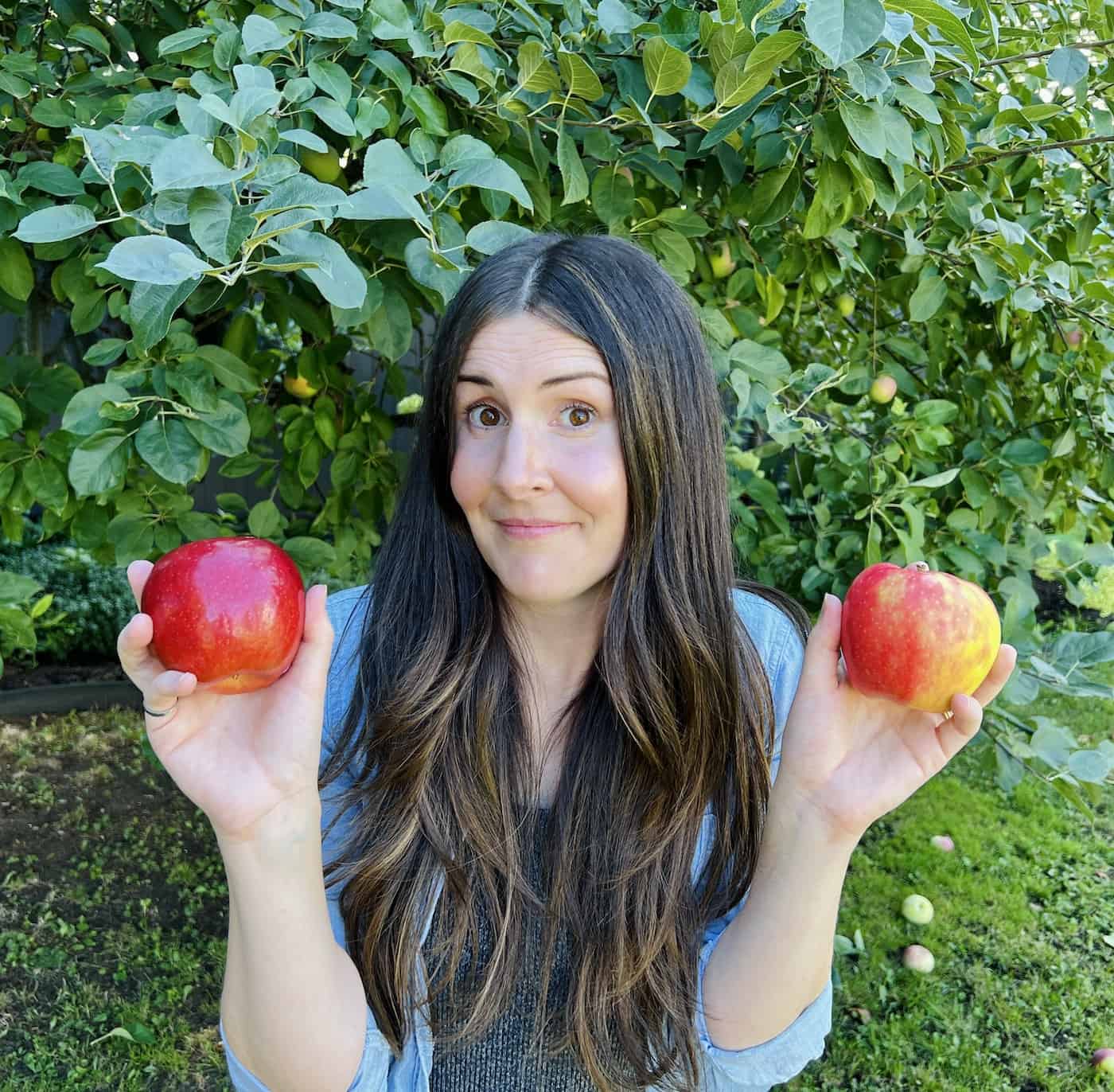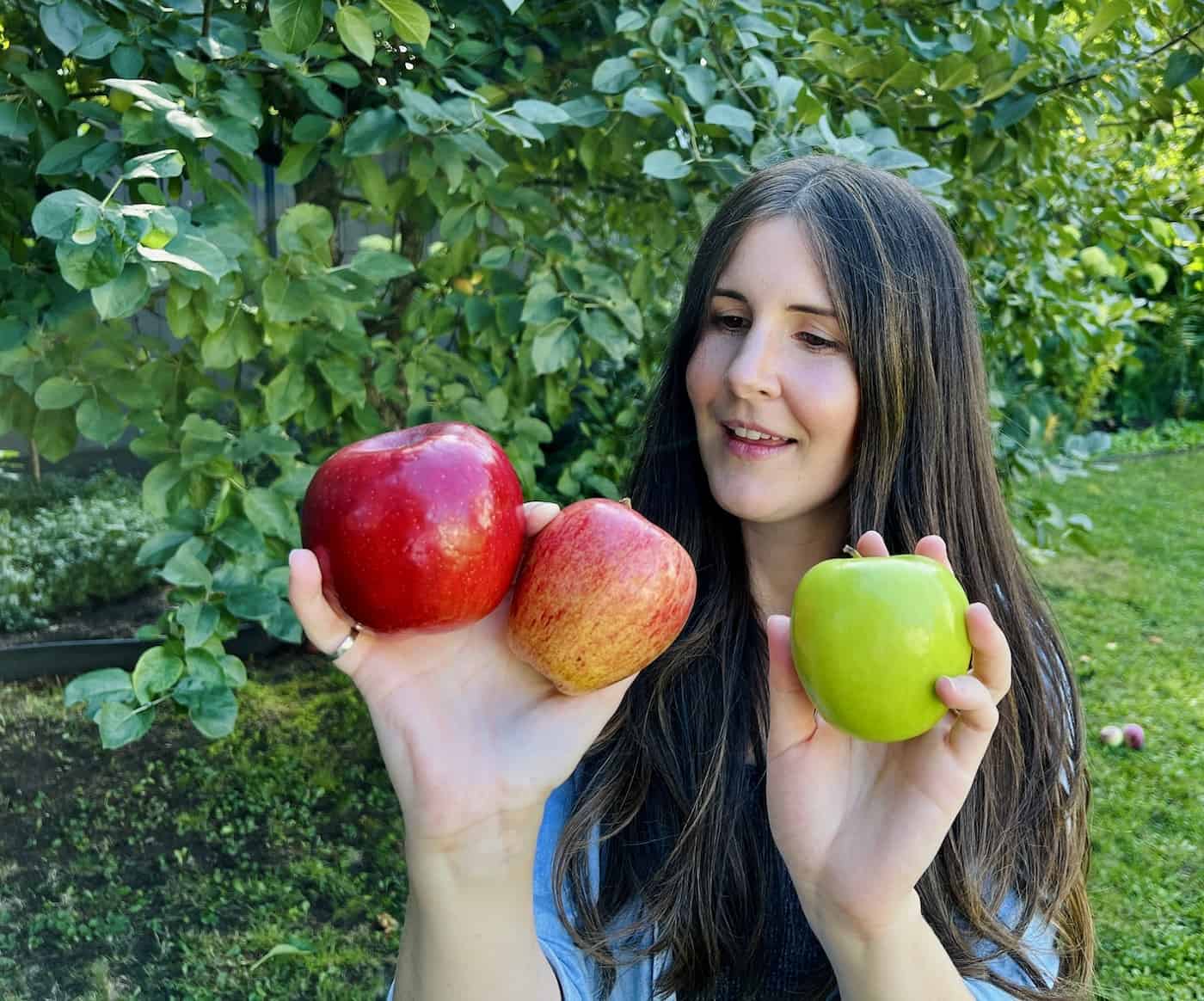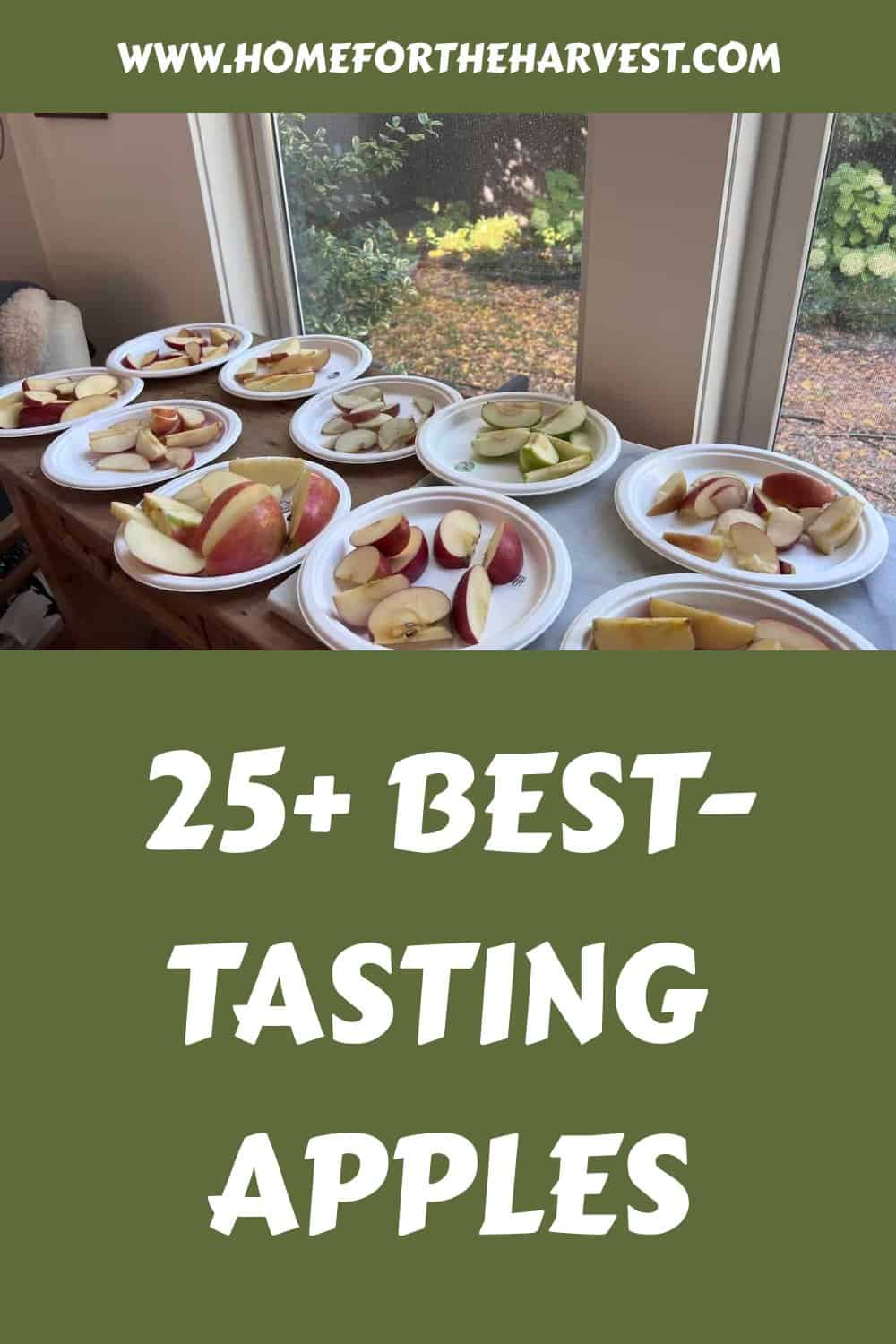Some of the best-tasting apple varieties are Honeycrisp, Pink Lady, Fuji, Ambrosia, and Cox’s Orange Pippin. Most varieties are most flavorful when picked at peak ripeness and eaten within a few months of harvest.
Gourmet apples are generally selected for superior texture, juiciness, aroma, and sugar/acid content. Apple flavor is also affected by autumn temperatures and the overall terroir of the growing region.
1. Honeycrisp
The Honeycrisp apple is a sweet-tart, incredibly crisp, all-purpose modern apple variety. Developed by the University of Minnesota, these large apples have a golden peel that ripens to a rosy-red blush. The Honeycrisp Apple is known for its strong apple flavor, a unique blend of sugar and acidity, and exceptionally crunchy texture. It’s hard to talk about the best-tasting apples without starting with the Honeycrisp!
One of the top all-around types of apples, Honeycrisp apples have a well-balanced taste that includes high levels of both floral sugars and fruity acids. Its juicy flavor truly does have notes of honey. Tree-ripened fruits can be so sweet and crunchy that they’re almost effervescent. Their firm texture means that they’re not only great for eating fresh, but also for use in baked dishes (or roasted, juiced, pressed, or dried).
The Honeycrisp is used as a parent variety in multiple breeding programs due to its wild popularity among consumers. Recent introductions bred using Honeycrisp include SweeTango, Cosmic Crisp, Rosalee, SugarBee, Scarlet Crush, Ruby Darling, Sweet Cheeks, and EverCrisp.
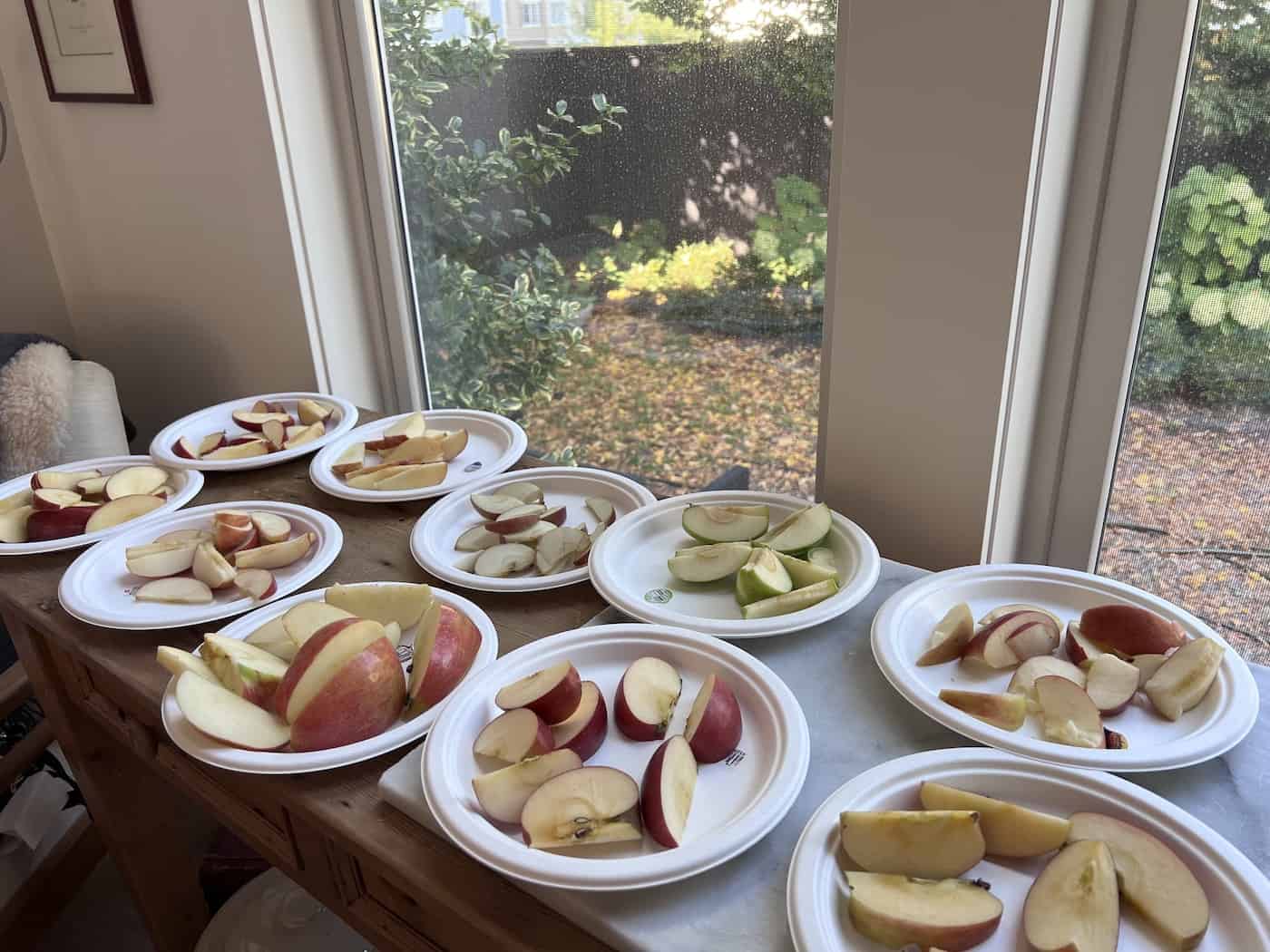
2. SweeTango
SweeTango apples (Minneiska cultivar) are sweet-tart, incredibly crisp, all-purpose modern club apples. This variety was developed at the University of Minnesota, which bred it as an improved version of their famous Honeycrisp. SweeTango is perhaps slightly sweeter than Honeycrisp, ripens earlier in the fall, and is easier to grow.
SweeTango apples are known for their crisp and juicy texture, as well as their excellent fresh-apple flavor. These juicy apples have a yellow background and a deep red, rosy blush.
One of the best-tasting apples, SweeTango builds on its Honeycrisp parentage with that exceptional honey-like sweetness. The flavor has notes of autumn spicy and sour citrus and is supremely well-balanced. These all-around winners are great sliced fresh or used in gourmet recipes.
SweeTango is a brand-name apple, with the name SweeTango trademarked by the University of Minnesota. As a club apple or managed variety, only licensed growers (those who are “in the club”) can grow and distribute SweeTango apples.
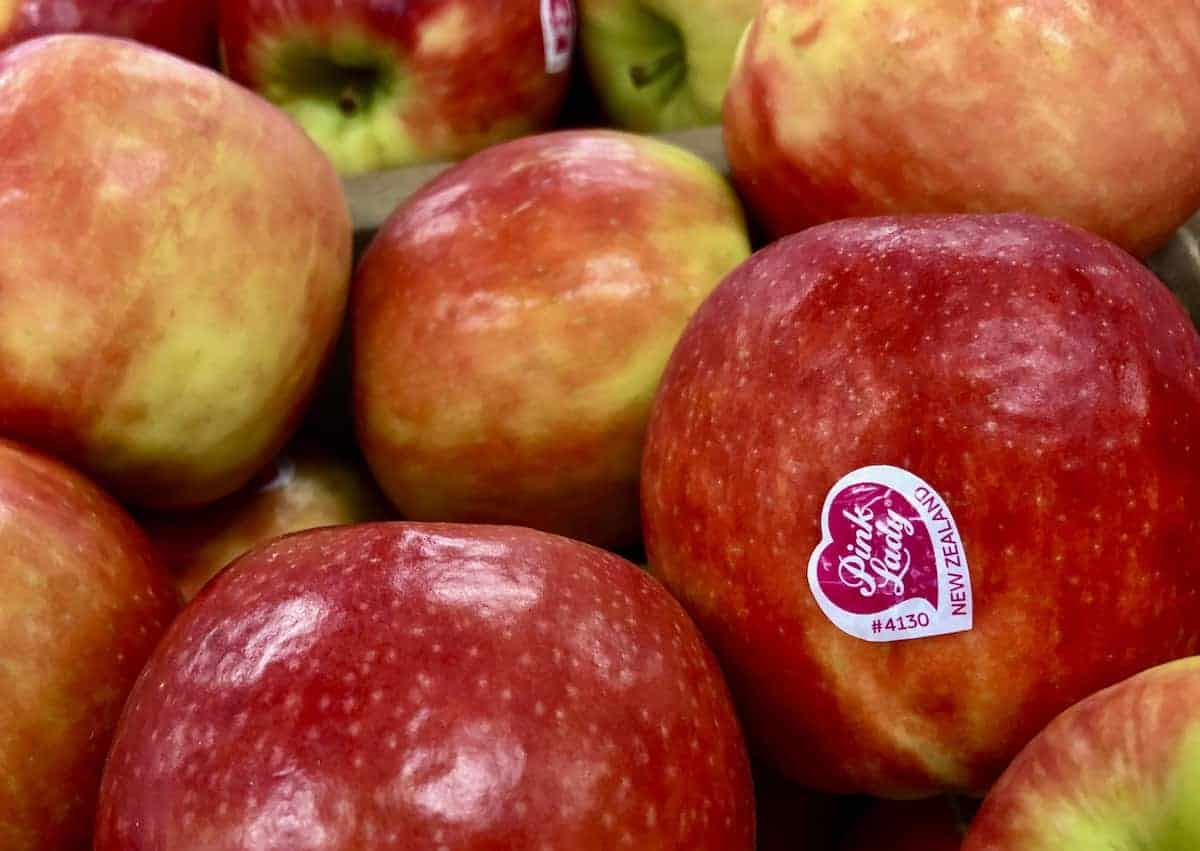
3. Pink Lady (Cripps Pink)
Pink Lady is a sweet-tart, crisp, all-purpose modern club apple. All Pink Lady apples are of the Cripps Pink cultivar (or natural mutations of Cripps Pink). These apples were bred in Australia, and are descended from the American Golden Delicious apple. Pink Lady apples are known for their distinctive rosy-pink blush peel coloring and general all-around appeal.
Among the best-tasting apple varieties, Pink Lady/Cripps Pink Apples are sweet and incredibly juicy with a well-balanced acidic sharp flavor. Their crisp white flesh has that fizzy effervescent quality without being overly sour. This is a refreshing apple that’s wonderful to eat fresh (and slow to turn brown after it’s sliced).
Cripps Pink has been used in modern apple breeding due to its excellent flavor and outstanding appearance. Offspring varieties of the Pink Lady apple include Sweet Cheeks, Scarlet Crush, and Wild Twist.
The Cripps Pink variety is licensed by the Department of Agriculture and Food, Western Australia (DAFWA), which developed it in the 1970s. Pink Lady is the brand-name version of the variety, with the name Pink Lady managed by Apple and Pear Australia Limited (APAL).
As a club apple or managed variety, only licensed “club” growers grow brand-name Pink Lady apples. There are, however, many growers who grow the same variety under their cultivar name “Cripps Pink”, as the US patent on the variety ran out in 2010. You can now even grow your own Cripps Pink apple tree at home!
“Every now and then, you get a truly ripe Pink Lady, and you know it: a crunchy mango bursts in your mouth, and the angels start to sing.”
Apples Of Uncommon Character: 123 Heirlooms, Modern Classics, & Little-Known Wonders, by Rowan Jacobsen
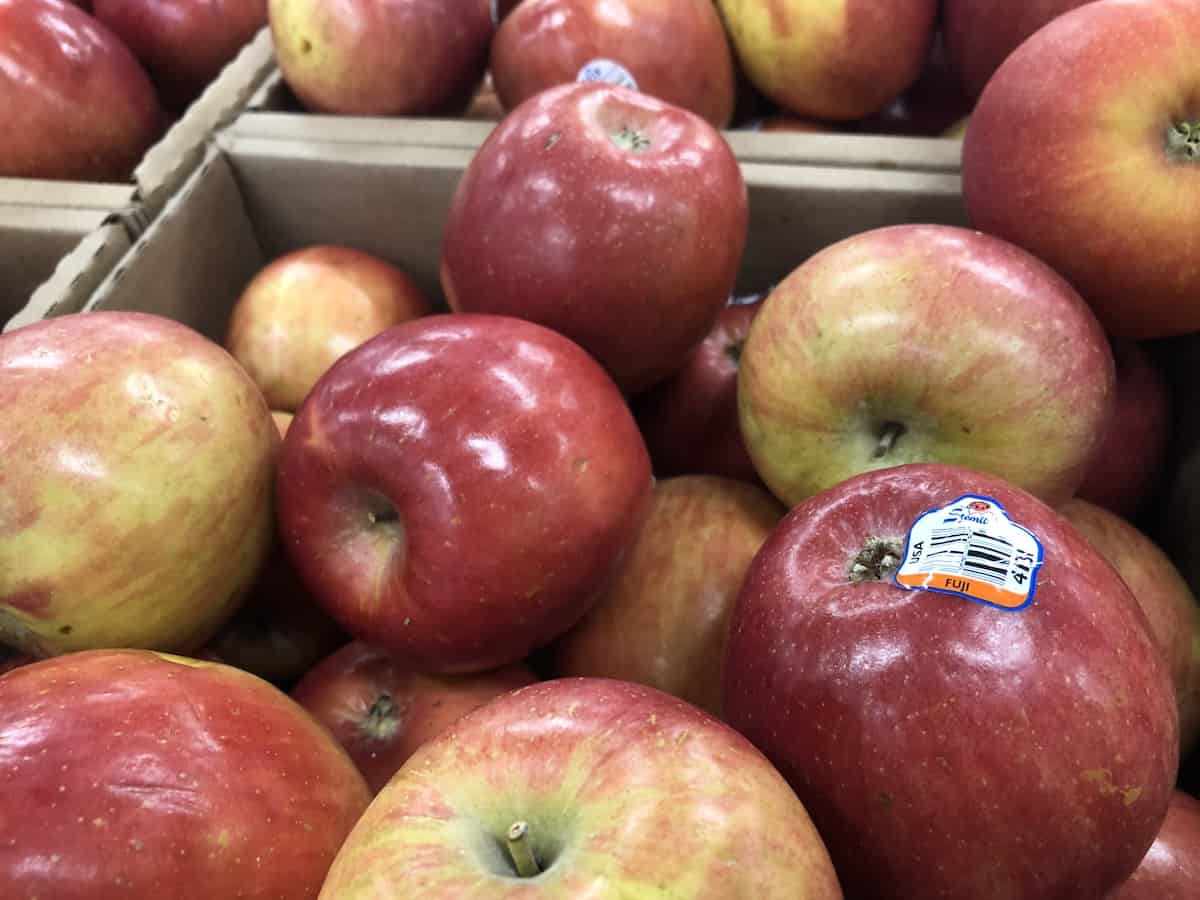
4. Fuji apples (the sweetest!)
Fuji is a very sweet, tender, fresh-eating modern apple variety. Developed in Japan, these apples have yellow skin with a red blush and sometimes red stripes. The Fuji Apple is known for its incredibly sweet flavor. These apples are the sweetest apples in the grocery store!
Fuji Apples have a honey-like sweetness and very low levels of acidity. Their floral aroma and flavor are not overly complex, making this variety perfect for those who like a simple, sweet fresh apple. Despite the lack of acidity, the texture of Fuji apples still has a satisfying fresh crunch. Fuji Apples are best enjoyed fresh as whole apples, apple slices, or in fresh recipes.
The Fuji is commonly used to breed new apple varieties. The Fuji brings an unmatched sweetness that the best new varieties certainly benefit from. New apples bred from the Fuji include Evercrisp, Autumn Glory, Rosalee, and Hokuto.
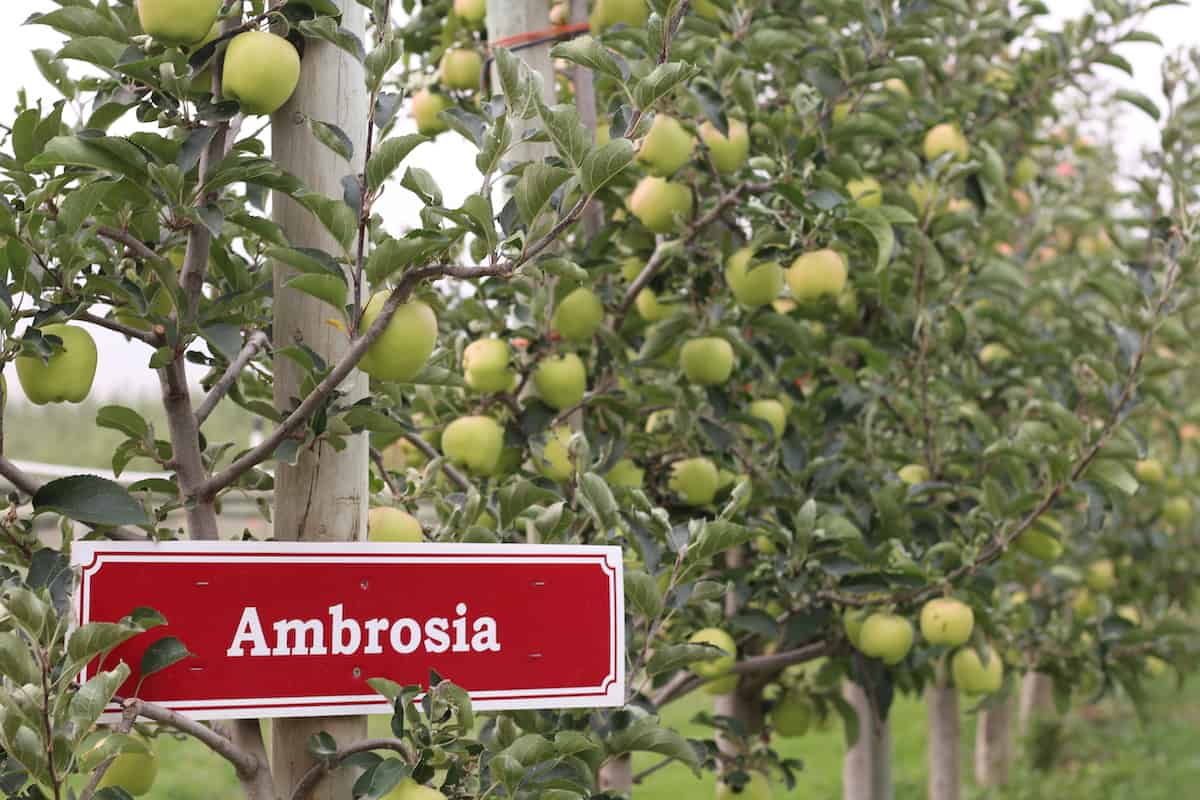
5. Ambrosia
Ambrosia is a honey-sweet, tender-yet-crisp, fresh-eating modern club apple variety. Discovered in British Columbia, Canada, these apples have a golden peel with a pretty rose-pink blush as they ripen. Among the best-tasting apples, Ambrosia Apples are known for their intense sweetness and heavenly floral aromatics.
Ambrosia Apples are richly sweet and low in acidity and are often available grown organically. The distinctive taste has a complex depth of floral notes and pear-like aromatics. Fresh Ambrosia fruits have firm flesh with a satisfying crisp texture when eaten fresh. While they can be used in cooked recipes, Ambrosia Apples are mainly enjoyed fresh or only very gently cooked.
The Ambrosia Apple is fairly new and is not known to be a parent to any other commercially-produced apple varieties. As a chance seedling, its own breeding is unknown, but likely includes the Golden Delicious as a parent or grandparent variety.
6. Cox’s Orange Pippin
Cox’s Orange Pippin is a sweet and crisp fresh-eating heirloom apple. Cox’s Apple was discovered in England as a chance seedling tree. True to their name, these apples are are warm yellow-orange color with a rich red blush. Cox’s Orange Pippin is quite possibly England’s favorite apple.
Cox’s Orange Pippin apples are sugary-sweet but also pack a nice acidic sharp flavor. They have fruity notes to their taste that can be almost tropical, especially in a good growing year. Cox’s Apples are a real treat to eat fresh, but they also can be used in baking, as they keep a nice firm texture when cooked.
The incredible flavor of Cox’s Orange Pippin has led to it being used as a parent variety to breed modern apple varieties like Fiesta and Piñata. Cox’s Orange Pippin is also a grandparent to the world-famous Gala, through its offspring variety Kidd’s Orange Red.
“Arguably the most famous – and delicious, if you ask me – eating apple in the world, the Cox’s Orange Pippin, to use its full title, is crisp, juicy and perfectly balanced.”
Apple: Recipes from the Orchard, by James Rich
7. Northern Spy
Northern Spy is a tart, firm heirloom baking apple variety. Discovered in New York state, these are large fruits with a pretty rich red peel. The Northern Spy is known as one of the best apple varieties for making apple pie.
Northern Spy apples have a sharp yet complex acidic flavor that sweetens with cooking. Their cooked taste has fruity citrus notes. They are almost always used in cooked recipes, especially apple pie, apple crisp, and apple crumble.
The Northern Spy has been used in apple breeding programs in cooler apple-growing regions due to its complex flavor and natural resistance to pests and disease. It is a parent apple to the Keepsake apple (another great pie apple), making the Northern Spy a likely grandparent to the ever-popular Honeycrisp.
“If I had to live on a desert island with only one apple variety, it might well be Northern Spy, which I think of as the Calville Blanc of the Northeast: A big, firm, sharply acidic, superb winter pie apple.”
Apples Of Uncommon Character: 123 Heirlooms, Modern Classics, & Little-Known Wonders, by Rowan Jacobsen
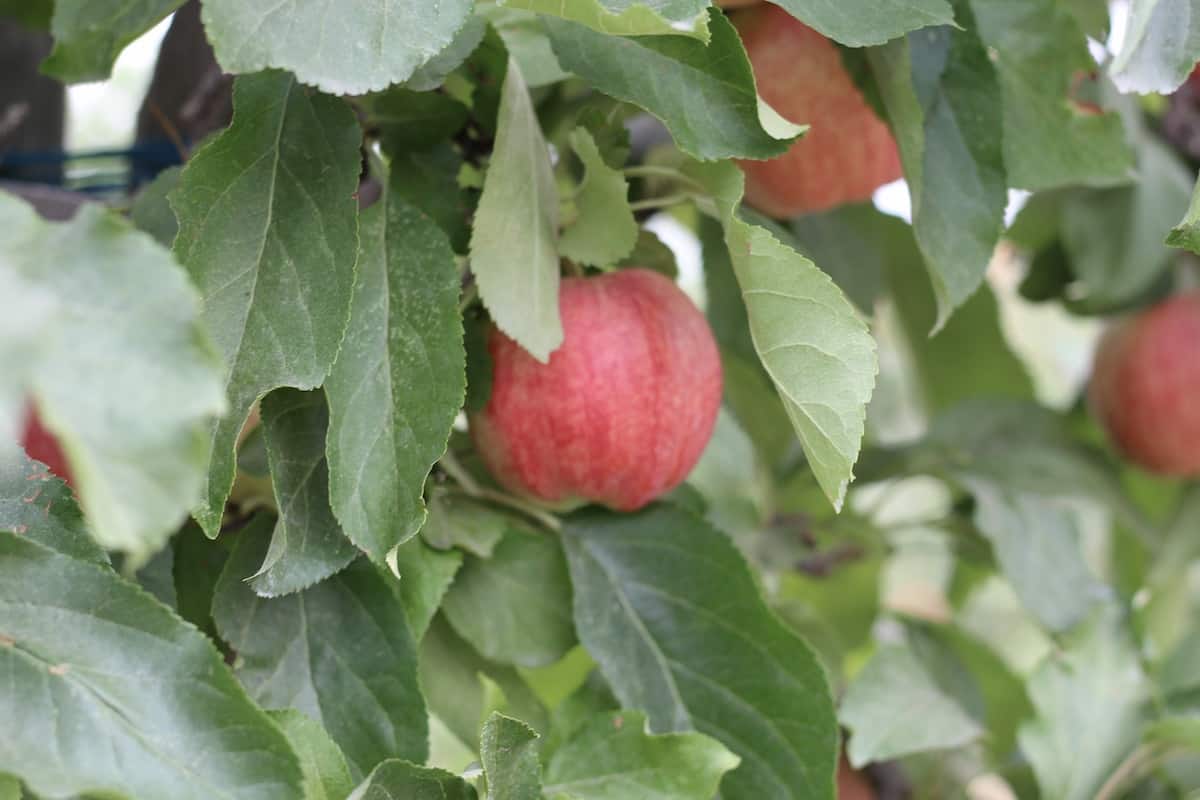
8. Gala
Gala is a sweet-tart, crisp, all-purpose modern apple variety. Developed in New Zealand, these apples have a yellow peel that ripens to a beautiful, rich red color, sometimes in vertical stripes. The Gala Apple is known as one of the tastiest and most dependable grocery store apples that are widely available and easy to find.
Like many of the best-tasting apples, a ripe Gala Apple has a juicy floral sweetness that’s balanced with a citrusy acidic sharpness. The Royal Gala can have a honey-like quality, especially when left to ripen on the tree. This is a true all-around apple that is just as good to eat fresh as it is to use in cooked recipes.
The Gala Apple is one of the most popular apple varieties for breeding new types of apples. Gala’s wide appeal has led to many popular offspring varieties, including Jazz, Envy, Sweetie, Kanzi, Dazzle, Ruby Darling, and Pacific Rose.
“One of the most widely available apples on the planet, Royal Gala apples are crisp, juicy and sweet with floral and vanilla notes. Incredibly divers, Royal Galas are great eating apples and can also be used in salads, chutneys and preserves, baking, and even diced into burger patties.”
Apple: Recipes from the Orchard, by James Rich
9. Braeburn
Braeburn is a sweet-tart, crisp, and juicy all-purpose modern apple. Discovered in New Zealand, this apple has a yellow background that matures to red stripes or even a rich red blush. The Braeburn apple is known for its excellent sweet yet acidic spicy complex flavor and suitability to almost any recipe.
Braeburn apples are sharp, sweet, and spicy! Their complex flavor has notes of fruit and of autumn spices, making it perfect for fall dishes. These apples are just as good in pies and tarts as they are when eaten straight from the orchard.
The Braeburn is commonly used in modern apple breeding programs due to its complex and appealing flavor and texture. It is often crossed with the Gala (another all-around favorite from New Zealand). Descendants of the Braeburn include Envy, Jazz, Sweetie, and Kanzi club apples.
10. Jazz
Jazz is a sweet-tart, crisp, and juicy all-purpose modern club apple variety. Developed in New Zealand as a cross between Gala & Braeburn, these apples have a bright yellow and red peel. Jazz apples are one of the most widely available brand-name club apples and are known as being one of the best all-around new varieties.
Jazz apples have a fruity sweetness and well-balanced refreshing acidity. These are crisp apples with fine-grained flesh. Jazz apples are juicy, and the juice has a honey-like sweetness with notes of pear. Jazz apples are delicious when eaten fresh, cooked, or baked.
While the Jazz apple isn’t known to be the parent apple of any other commercial varieties, it does have some famous siblings! Other Gala-Braeburn cross apples include Envy, Sweetie, and Kanzi.
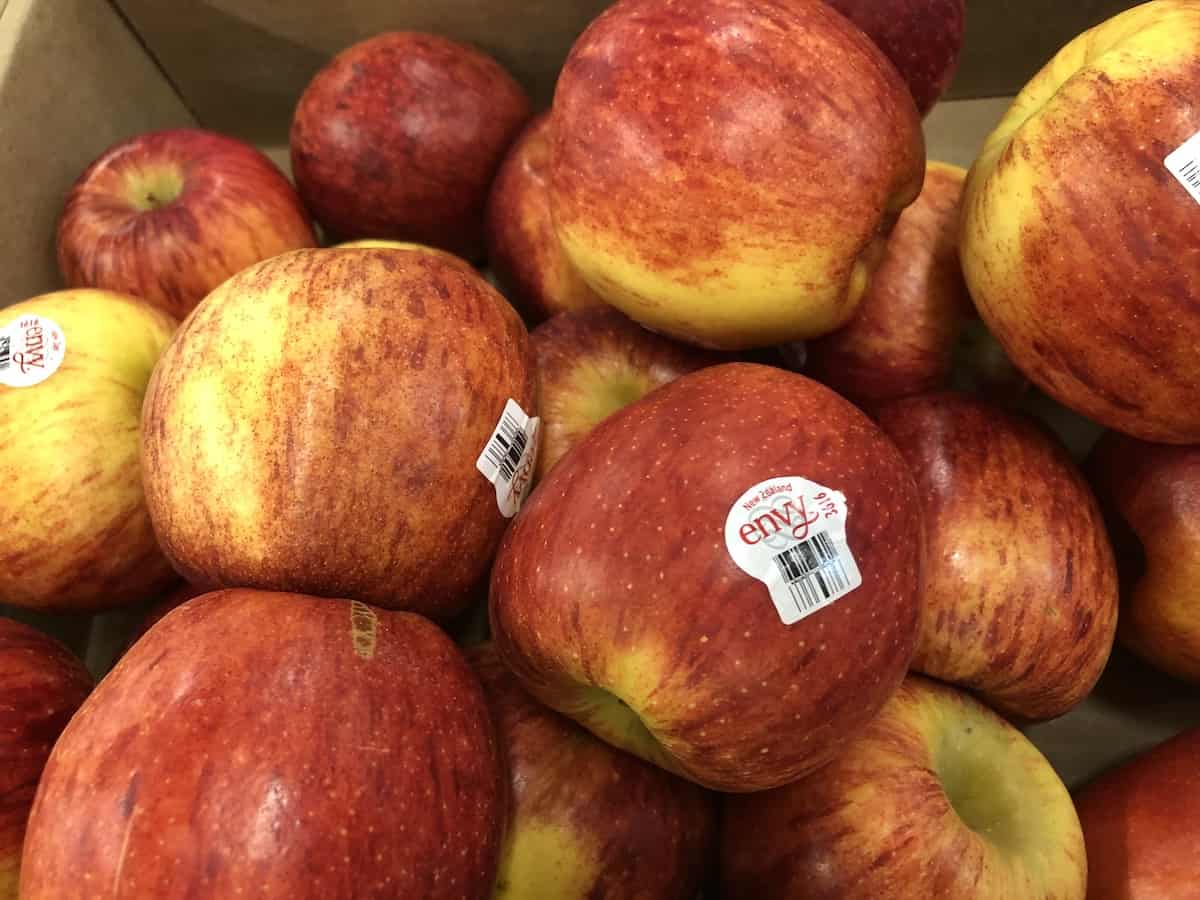
11. Envy
Envy is a sweet-tart, crisp, all-purpose modern club apple variety. Developed in New Zealand, this Gala-Braeburn offspring has a gorgeous deep red peel. Envy Apples are known for their stand-out fresh flavor as one of the best-tasting apples, as well as their versatility in cooking as an all-purpose apple.
Envy apples have a perfect balance of sugary sweetness and sharp acidity. Their flavor is deep and complex and they have a satisfying firm, crunchy texture. They are excellent for eating fresh, but can also be used in cooked recipes and baking.
Envy Apples are a relatively new Braeburn-Gala cross variety. Think of them as a younger sibling to the Jazz apple.
12. Granny Smith
Granny Smith is a tart and firm all-purpose heirloom apple variety. Discovered in Australia over a hundred years ago, they are easily recognized by the bright green peel. The Granny Smith is known as the most popular of the green apple varieties, a common apple variety for apple pie filling, and a favorite fresh-eating type for sour apple lovers.
Granny Smith’s apples are tart with a sharp acidity. They have a lemony citrus aroma and firm, crunchy texture. Granny Smith is one of the best all-purpose tart apples, as it can be eaten either fresh or cooked/baked.
The Granny Smith apple is not a common parent variety in modern apple breeding as customer preference tends toward sweet apples rather than sour apples. That said, Granny Smith is thought to be a parent apple of the Lady Williams Apple (also Australian), making it a grandparent variety of the Pink Lady/Cripps Pink club apple.
13. Golden Delicious
Golden Delicious is a sweet and juicy all-purpose heirloom apple variety. Discovered in West Virginia, these apples have a distinctive golden yellow peel. Golden Delicious Apples are easy-to-find sweet apples that are stocked in most supermarkets throughout the year.
Golden Delicious apples are very sweet with just a hint of acidity when ripe. Their taste is mild overall, becoming even less acidic and sweeter in storage. Golden Delicious Apples are the best tasting when picked at peak ripeness and enjoyed within a few months of being picked.
Golden Delicious apples are available to buy out of season, but their flavor is not nearly as distinctive. Green-yellow freshly picked apples are best for baking, while golden-yellow ripe apples are sweeter for eating fresh. Apples picked while green and underripe generally don’t have the smooth floral sweetness of tree-ripened fruits.
The Golden Delicious apple is one of the most widely-used apple varieties for breeding new modern apples. Offspring apples of the Golden Delicious include Gala, Mutsu/Crispin, Piñata, Autumn Glory, Cameo, Dorsett Golden, Opal, and Splendour.
14. Jonagold
Jonagold is a sweet-tart, juicy, all-purpose modern apple variety. Developed in New York state, these apples have a golden peel with a rosy red blush. The Jonagold apple is known for its versatility and perfectly balanced flavor.
A cross between the honey-sweet Golden Delicious and the spicy, flavourful Jonathan apple, the Jonagold combines the best of both parent varieties. These juicy apples are wonderful for eating fresh, making apple juice, or baking apple pie or crisp.
The Jonagold apple is not widely used in breeding new apples, nor does it have sibling apples produced commercially. There are, however, quite a few natural mutations (called “sports”), including Jonagored. Other popular apples descended from the Jonathan Apple include the Jonamac (McIntosh cross) and Idared (Wagener cross).
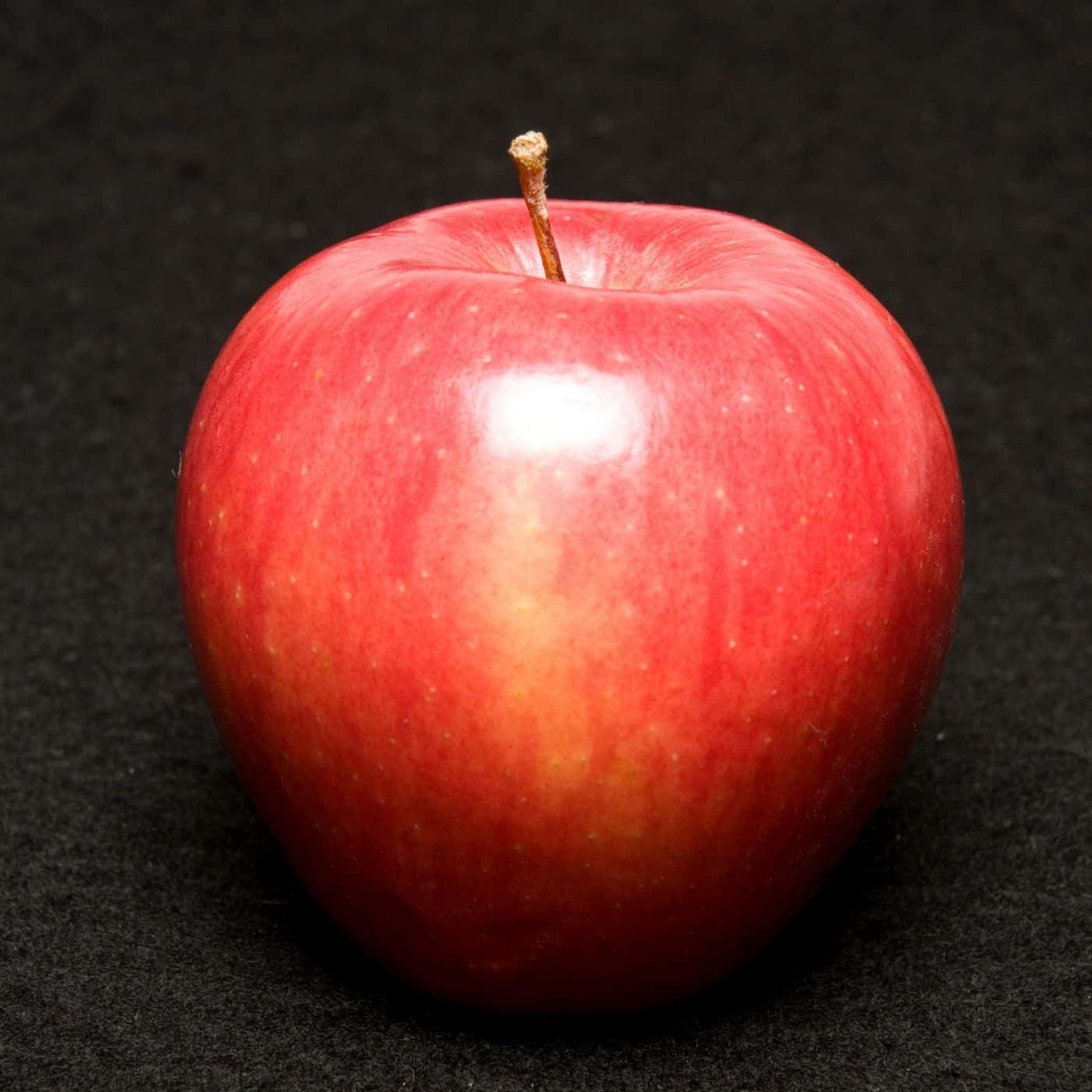
15. Piñata
Piñata is a sweet-tart, crisp, all-purpose modern club apple variety. Developed in Germany and grown in the USA by Stemilt, these apples have a bright yellow peel with vibrant orange and red stripes. Piñata Apples are known as high-quality club apples that are fantastic for eating fresh and for use in gourmet cooking.
Piñata Apples are a perfect mixture of tart and sweet flavors. They have an almost tropical fruity twist with subtle notes of coconut and pineapple. The honey-like sweetness is well balanced with a citrusy acidity. This is a modern apple with an heirloom-quality taste.
Piñata Apples are descended from some particularly tasty heirloom varieties, which is likely the reason for their excellent flavor. The heirlooms used to develop the Piñata are the Golden Delicious (USA), Cox’s Orange Pippin (England), and Duchess of Oldenburg (Russia).
16. Pixie Crunch
Pixie Crunch is a sweet, crisp, small all-purpose modern apple. Developed in Indiana, these apples have a perfectly red peel. Pixie Crunch Apples are known for being perfect for kids, as they are quite small, have thin skin, and are perfectly sweet and crispy.
Pixie Crunch Apples are so sweet that they’re almost like candy apples. They’re mainly eaten fresh and are absolutely adored by kids. You can even grow them in your backyard!
“If I was designing a fruit to beguile every child in he world, I would design the Pixie Crunch. Crisp as a chip, sweet as candy. Fits perfectly in a pint-size hand. Irresistibly red.”
Apples Of Uncommon Character: 123 Heirlooms, Modern Classics, & Little-Known Wonders, by Rowan Jacobsen
17. Crispin/Mutsu
Crispin (also called Mutsu) is a sweet-tart, crisp, and juicy all-purpose modern apple variety. Developed in Japan, these apples have a yellow-green peel with an orange-red patchy blush. Crispin Apples are known for their crisp texture and well-balanced sweetness and are a reliable and versatile variety.
Crispin/Mutsu Apples are quite sweet with nice balanced acidity. The flavor is subtle and delicate, especially after a month or two in storage. They have a little bit of that lovely green-apple sour tang. These apples are wonderful to eat fresh off the tree but are also well known for their use in baking.
While Crispin/Mutsu Apples aren’t commonly used in modern apple breeding, they do have two famous siblings. The Mutsu/Crispin, Orin, and Shizuka apples were all developed in Japan as crosses of Golden Delicious with the Indo apple.
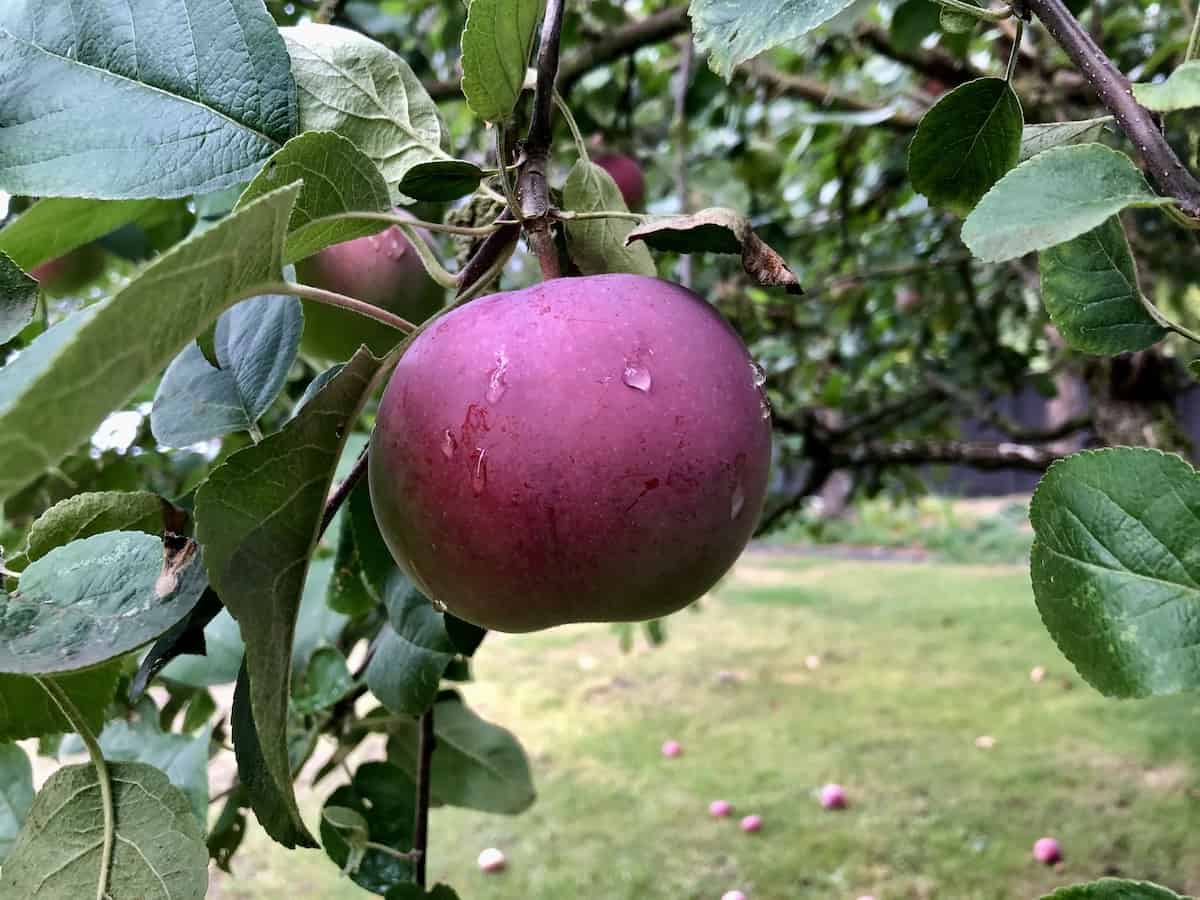
18. McIntosh
McIntosh is a tart-sweet, tender all-purpose heirloom apple variety. Discovered in Ontario, Canada, these apples develop a distinctive bright red blush over their bright green peel. McIntosh apples are known as one of the best apples for applesauce and are also a favorite fresh-eating variety for tart apple lovers.
McIntosh apples are tart but also have an unexpected honey sweetness when ripened on the tree. In growing years with cool autumn weather, the flesh can be almost spicy, similar to Braeburn.
The soft pulp of McIntosh apples cooks quickly and should be used in recipes where a pureed apple texture is desirable. It is quite common to mix tender McIntosh apples with firmer Granny Smiths to make a well-textured apple pie filling.
The McIntosh Apple is often used in apple breeding due to its popular flavor and cold-hardy growth characteristics. Offspring varieties of the McIntosh Apple include Empire, Cortland, Macoun, Spartan, and Spencer varieties. It’s also a grandparent to the Liberty apple.
19. Empire
Empire is a tart, tender all-purpose modern apple variety. Developed in New York State, these apples were bred from McIntosh and Red Delicious parents, leading to soft and tart flesh inside an attractive deep red peel. These apples are known as some of the most attractive deep-red tart-tasting apples.
Empire Apples are tart but mild. They have a wonderful crunchy firm texture when perfectly ripe. They’re a good tart apple for those who prefer sweeter apples, as they’re not overly sour. They’re also gorgeous, which doesn’t hurt. Empire Apples are a favorite for eating fresh right from the tree, and also for lovely pink applesauce.
20. Cortland
Cortland is a tart, tender, all-purpose heritage apple variety. Developed in New York state more than 100 years ago, these apples were bred by crossing McIntosh with the bright-red Ben Davis apple. Cortlands are great for slicing as they’re slow to brown and are also known as a nice apple to add to your apple pie filling mix or applesauce.
Cortland Apples have a gentle tart-sweet flavor when ripe. Under-ripe fruit can be quite tart, while over-ripe apples can be soft, sweet, and mealy. Choose freshly picked fruits for the best taste and texture. Snap these apples up while they’re in season (October-December).
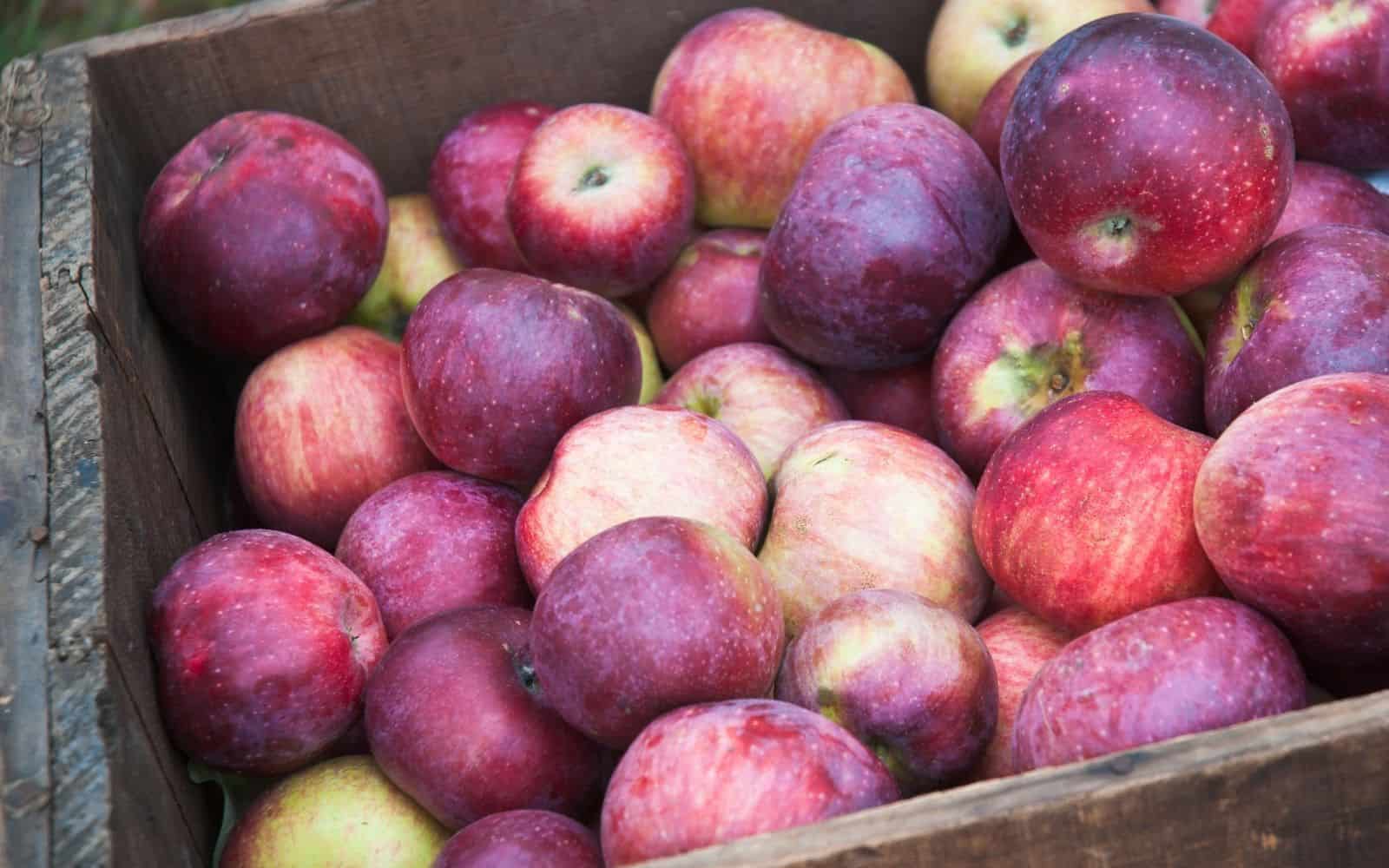
21. Macoun
Macoun is a tart-sweet, juicy, all-purpose heritage apple variety. Like Cortland, Macoun was developed in New York State more than 100 years ago. The Macoun is a cross between the McIntosh and the Jersey Black apple. The result is like a sweeter Mac with a darker peel. Yum!
Macoun apples are very well balanced in terms of the amounts of acidity and sweetness. Flavor varies from year to year and from region to region but is generally regarded as excellent. The flavor of the Macoun apple is sometimes regarded as more complex than that of other McIntosh offspring like the Cortland and the Empire.
22. Bramley’s Seedling
Bramley’s Seedling is a tart, crisp, heirloom cooking apple. Discovered in the UK more than 200 years ago, this culinary apple is yellow with pretty rosy-red stripes down the sides. Bramley’s Apple is known for its sharp acidity that mellows to a lovely complex apple flavor in baked dishes.
Bramley’s Seedling Apples are quite tart and sour. The flesh is fine but firm, making it excellent for both sliced and pureed cooked apple recipes. The Bramley Apple is rarely eaten fresh and is almost always used in cooked applications – especially apple pies, fruit compotes, and tart applesauce.
23. Esopus Spitzenburg
Esopus Spitzenburg is a tart, crisp, all-purpose heirloom apple variety. Discovered in New York state, these apples have smooth yellow-green skin with deep red stripes. Esopus Spitzenburg apples are known for their incredible depth of flavor and are often sought out by chefs and apple connoisseurs.
These apples have the characteristic vibrant acidity of a tart apple but also have a well-balanced sweetness. These are spicy, citrusy, aromatic apples. Like some of the best tart-sweet varieties, they have enough acid to be almost effervescent, but with enough balanced sweetness to keep from being sour.
Esopus Spitzenburgs are a treat to eat fresh but are also a special variety to include in baked recipes. The Esopus Spitzenburg is thought to be a parent variety of the classic Jonathan heritage apple, from which Jonagold, Jonamac, and Idared are descended.
24. Egremont Russet
Egremont Russet is a tart-sweet, dry, all-purpose heirloom apple variety. Discovered in England, these apples have a rough peel that’s completely covered with russeting, which makes them look a bit like a round potato. But these apples are a diamond in the rough! Egremont Russet apples are known for their unique and distinctive flavor profile.
Egremont Russet apples have both sweetness and acidity, but also an unexpected nutty flavor. These are woodsy, smoky apples that are unlike anything you’ll find at the supermarket. Egremont Russet apples are perfect for serving on a cheese board or pressing into your own custom apple juice or apple cider.
25. Hudson’s Golden Gem
Hudson’s Golden Gem is a sweet, juicy, all-purpose heritage apple variety. Discovered in Oregon, this chance seedling apple is fully russeted – meaning it has that rough, brown, potato-like skin. Hudson’s Golden Gem is known as a favorite of apple connoisseurs and locavores, who search it out for its top-notch flavor.
Hudson’s Golden Gem apples are sweet and pear-like with nutty aromatics that are classic for russet-style apples. They are juicy and tender fruits. Try one fresh to experience the raw flavor, but they can also be used to make applesauce or added to cooked apple recipes to add a wonderful depth of flavor.
26. Ginger Gold
Ginger Gold is a sweet-tart, crisp, all-purpose modern apple variety. Discovered by chance in Virginia, these apples are small with a yellow-green peel. They are known as one of the best-tasting early apple varieties, and are sometimes harvested in late July!
Ginger Gold apples are sweet for early apples but do have that classic early-apple citrusy tartness. They’re more tart than a Golden Delicious, but again, still quite sweet. They’re slow to brown, making them great for sliced summer dishes, salads, and sandwiches. They can also be used in cooking or baking.
27. Fiesta
Fiesta is a sweet-tart, crisp, all-purpose modern apple variety. Developed in England, these apples have a yellow-green peel that ripens with bright red vertical stripes. Bred as a cross between Cox’s Orange Pippin and the Idared apple, Fiesta apples are wonderfully flavourful but also store very well.
Fiesta apples have a balanced sweet-tart taste with a well-rounded flavor. They can be substituted for Cox’s apples if need be, as they’re quite similar in taste and almost as aromatic. Fiesta apples are wonderful to eat fresh, juiced, in applesauce, or as part of your apple pie filling blend.
28. Fameuse (snow apple)
Fameuse is a sweet-tart, tender, fresh-eating heirloom apple variety. Also called snow apple, this French-Canadian beauty has bright red skin and snow-white flesh. Fameuse are specialty apples that are available for a few months after harvest, typically October-December.
Fameuse apples are refreshing and crisp, with hints of autumn spice. They have a fruity sweetness to them, and these apples should definitely be left on the tree to ripen rather than picked early for storage. Sweetness increases with cooler fall temperatures. One of the reasons that the Fameuse is sought out by apple aficionados is that it’s thought to be a parent apple of the McIntosh.
29. Grimes Golden
Grimes Golden is a true heritage apple variety from the United States. Discovered in West Virginia over 200 years ago, Grimes is excellent for fresh eating, cider, and applesauce. These small round apples are truly yellow, often with a slight bit of russeting by the stem.
Grimes Golden Apples are sweet and flavorful with fruity and slightly spicy notes. The flesh is fine-grained yet crunchy making for a satisfying fresh-eating experience. Look for this variety in September in southern growing areas where the flavor and peel color develop best.
